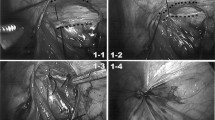Abstract
Background
Laparoscopic inguinal hernia repair is rarely reported in pediatric patients. We report our experience on this topic to show the standardization of the technique.
Methods
In a 3-year period we operated 315 patients for unilateral inguinal hernia using laparoscopy. Fifty of the 315 patients (15.9 %) were younger than 1 year old. The age ranged from 1 month to 8 years (median 3.2) with a median body weight of 14.3 kg. We always used three trocars, and we used the modified laparoscopic herniorraphy according to Montupet. After sectioning the sac distally to the ring, the periorificial peritoneum was closed with a purse-string suture of nonresorbable suture material.
Results
The operating time averaged 25 min. All the procedures were performed in a day-hospital setting. In 123/315 patients (39 %), at operation we found a contralateral patency of the processus vaginalis. In these 123 cases we performed a bilateral herniorraphy. In one girl (0.3 %) we found a coexistence of oblique external hernia and a direct hernia, and both orifices were sutured in laparoscopy. We recorded only 1 minor complication: a problem with needle extraction. With a minimum follow-up of 1 year, there were 2 recurrences (0.6 %).
Conclusions
We believe that laparoscopic repair of inguinal hernia in expert hands is a safe and effective procedure. It makes it possible to repair all forms of inguinal hernia simultaneously, together with contralateral patencies, which has cemented its role as an alternative to conventional repair.







Similar content being viewed by others
References
Kiesewetter WB, Oh KS (1980) Unilateral inguinal hernias in children. Arch Surg 115:1443–1445
Lau ST, Lee YH, Caty MG (2007) Current management of hernias and hydroceles. Semin Pediatr Surg 16:50–57
Montupet P, Esposito C (1999) Laparoscopic treatment of congenital inguinal hernia in children. J Pediatr Surg 34:420–423
Harrison CB, Kaplan GW, Scherz HC (1990) Diagnostic pneumoperitoneum for the detection of the clinically occult contralateral hernia in children. J Urol 144:510–511
Jona JZ (1996) The incidence of positive contralateral inguinal exploration among preschool children—a retrospective and prospective study. J Pediatr Surg 31:656–660
McGregor DB, Halverson K, McVay CB (1980) The unilateral pediatric inguinal hernia: should the contralateral side be explored. J Pediatr Surg 15:313–317
Rothenberg RE, Barnett T (1955) Bilateral herniotomy in infants and children. Surgery 37:947–950
Schier F, Montupet P, Esposito C (2002) Laparoscopic inguinal herniorrhaphy in children: a three-center experience with 933 repairs. J Pediatr Surg 37:323–327
Esposito C, Montupet P (1998) Laparoscopic treatment of recurrent inguinal hernia in children. Pediatr Surg Int 1:12–15
Holcomb GW III, Brock JW III, Morgan WM III (1994) Laparoscopic evaluation for a contralateral patent processus vaginalis. J Pediatr Surg 29:970–974
Radmayr C, Corvin S, Studen M et al (1999) Cryptorchidism, open processus vaginalis, and associated hernia: laparoscopic approach to the internal inguinal ring. Eur Urol 36:631–634
Rescorla FJ, West KW, Engum SA (1997) The “other side” of pediatric hernias: the role of laparoscopy. Am Surg 63:690–693
Lee SL, DuBois JJ (2000) Laparoscopic diagnosis and repair of pediatric femoral hernia. Initial experience of four cases. Surg Endosc 1:1110–1113
Owings EP, Georgeson KE (2000) A new technique for laparoscopic exploration to find contralateral patent processus vaginalis. Surg Endosc 14:114–116
Surana R, Puri P (1993) Is contralateral exploration necessary in infants with unilateral inguinal hernia? J Pediatr Surg 28:1026–1027
Gilbert M, Clatworthy HW (1959) Bilateral operations for inguinal hernia and hydrocele in infancy and childhood. Am J Surg 7:255–259
Sparkman RS (1962) Bilateral exploration in inguinal hernia in juvenile patients. Surgery 51:393–406
Schier F, Turial S, Hückstädt T et al (2008) Laparoscopic inguinal hernia repair does not impair testicular perfusion. J Pediatr Surg 43:131–135
Shalaby R, Desoky A (2002) Needlescopic inguinal hernia repair in children. Pediatr Surg Int 1:13–16
Schier F (2000) Direct inguinal hernias in children: laparoscopic aspects. Pediatr Surg 16:62–66
Takehara H, Hanaoka J, Arakawa Y (2008) Laparoscopic strategy for inguinal ovarian hernias in children: when to operate for irreducible ovary. J Laparoendosc Adv Surg Tech A 11:767–771
Schier F (1998) Laparoscopic herniorrhaphy in girls. J Pediatr Surg 33:1495–1497
Author information
Authors and Affiliations
Corresponding author
Rights and permissions
About this article
Cite this article
Esposito, C., Montinaro, L., Alicchio, F. et al. Technical Standardization of Laparoscopic Herniorraphy in Pediatric Patients. World J Surg 33, 1846–1850 (2009). https://doi.org/10.1007/s00268-009-0121-4
Published:
Issue Date:
DOI: https://doi.org/10.1007/s00268-009-0121-4




